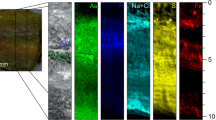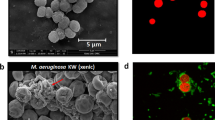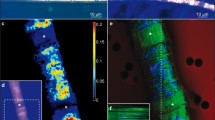Abstract
Microorganisms living in hypersaline microbial mats frequently form consortia under stressful and changing environmental conditions. In this paper, the heterotrophic strain DE2010 from a microalgae consortium (Scenedesmus sp. DE2009) from Ebro Delta microbial mats has been phenotypically and genotypically characterized and identified. In addition, changes in the morphology and biomass of this bacterium in response to nitrogen deficiency stress have been evaluated by correlative light and electron microscopy (CLEM) combining differential interference contrast (DIC) microscopy and transmission electron microscopy (TEM) and scanning electron microscopy (SEM). These isolated bacteria are chemoorganoheterotrophic, gram-negative, and strictly aerobic bacteria that use a variety of amino acids, organic acids, and carbohydrates as carbon and energy sources, and they grow optimally at 27 °C in a pH range of 5 to 9 and tolerate salinity from 0 to 70‰ NaCl. The DNA-sequencing analysis of the 16S rRNA and nudC and fixH genes and the metabolic characterization highlight that strain DE2010 corresponds to the species Ochrobactrum anthropi. Cells are rod shaped, 1–3 μm in length, and 0.5 μm wide, but under deprived nitrogen conditions, cells are less abundant and become more round, reducing their length and area and, consequently, their biomass. An increase in the number of pleomorphic cells is observed in cultures grown without nitrogen using different optical and electron microscopy techniques. In addition, the amplification of the fixH gene confirms that Ochrobactrum anthropi DE2010 has the capacity to fix nitrogen, overcoming N2-limiting conditions through a nifH-independent mechanism that is still unidentified.




Similar content being viewed by others
References
Aquilantia L, Favilib F, Clementi F (2004) Comparison of different strategies for isolation and preliminary identification of Azotobacter from soil samples. Soil Biol Biochem 36:1475–1483
Bal AK, Shantharam S, Verma DPS (1980) Changes in the outer cell wall of Rhizobium during development of root nodule symbiosis in soybean. Can J Microbiol 26:1096–1103
Batut J, Andersson SG, O’Callaghan D (2004) The evolution of chronic infection strategies in the alphaproteobacteria. Nat Rev Microbiol 2:993–945
Berrendero-Gómez E, Johansen JR, Kaštovský J, Bohunická M, Čapková K (2016) Macrochaetegen. nov. (Nostocales, Cyanobacteria), a taxon morphologically and molecularly distinct from Calothrix. J Phycol 52:638–655
Black M, Moolhuijzen P, Chapman B, Barrero R, Howieson J, Hungria M, Bellgard M (2012) The genetics of symbiotic nitrogen fixation: comparative genomics of 14 rhizobia strains by resolution of protein clusters. Genes 3(1):138–166
Burgos A, Maldonado J, De los Rios A, Solé A, Esteve I (2013) Effect of copper and lead on two consortia of phototrophic microorganisms and their capacity to sequester metals. Aquat Toxicol 140–141:324–336
Cahová H, Winz ML, Höfer K, Nübel G, Jäschke A (2014) NAD captureSeq indicates NAD as a bacterial cap for a subset of regulatory RNAs. Nature 519:374–377
Chakravarty R, Banerjee PC (2008) Morphological changes in an acidophilic bacterium induced by heavy metals. Extremophiles 12:279–284
Chen W, de Faria S, James E, Elliott G, Lin K, Chou J, Sheu S, Cnockaert M, Sprent J, Vandamme P (2007) Burkholderia nodosa sp. nov., isolated from root nodules of the woody Brazilian legumes Mimosa bimucronata and Mimosa scabrella. Int J Syst Evol Microbiol 57(5):1055–1059
Cole JJ (1982) Interactions between bacteria and algae in aquatic ecosystems. Annu Rev Ecol Syst 13(1):291–314
Cole JK, Hutchison JR, Renslow RS, Kim YM, Chrisler WB, Engelmann HE, Dohnalkova AC, Hu D, Metz TO, Fredrickson JK, Lindemann SR (2014a) Phototrophic biofilm assembly in microbial-mat-derived unicyanobacterial consortia: model systems for the study of autotroph-heterotroph interactions. Front Microbiol 5:109
Cole JR, Wang Q, Fish JA, Chai B, McGarrell DM, Sun Y, Brown CT, Porras-Alfaro A, Kuske CR, Tiedje JM (2014b) Ribosomal Database Project: data and tools for high throughput rRNA analysis. Nucleic Acids Res 42:D633–D642
Croft MT, Lawrence AD, Raux-Deery E, Warren MJ, Smith AG (2005) Algae acquire vitamin B12 through a symbiotic relationship with bacteria. Nature 438:90–93
Cushnie TPT, O’Driscoll NH, Lamb AJ (2016) Morphological and ultrastructural changes in bacterial cells as an indicator of antibacterial mechanism of action. Cell Mol Life Sci 73:4471–4492
Dalgaard P, Ross T, Kamperman L, Neumeyer K, McMeekin TA (1994) Estimation of bacterial growth rates from turbidimetric and viable count data. Int J Food Microbiol 23(3–4):391–404
Diestra E, Solé A, Martí M, Garcia De Oteyza T, Grimalt JO, Esteve I (2005) Characterization of an oil-degrading Microcoleus consortium by means of confocal scanning microscopy, scanning electron microscopy and transmission electron microscopy. Scanning 27:176–180
Diestra E, Esteve I, Burnat M, Maldonado J, Sole A (2007) Isolation and characterization of heterotrophic bacterium able to grow in different environmental stress conditions, including crude oil and heavy metals. In: A Menendez-Vilas (Ed) Communicating Current Research and Educational Topics in Applied Microbiology, 7th edn. pp 90–99
Doetsch RN (1981) Determinative methods of light microscopy. In: Gerhardt P, Murray RGE, Costilow RN, Nester EW, Wood WA, Krieg NR, Phillips GB (eds) Manual of methods for general bacteriology. American Society for Microbiology, Washington, D.C., pp 21–33
Edgren T, Nordlund S (2004) The fixABCX genes in Rhodospirillum rubrum encode a putative membrane complex participating in electron transfer to nitrogenase. J Bacteriol 186:2052–2060
Esteve I, Martínez-Alonso M, Mir J, Guerrero R (1992) Distribution, typology and structure of microbial mat communities in Spain: a preliminary study. Limnetica 8:185–195
Esteve I, Ceballos D, Martínez-Alonso M, Gaju N, Guerrero R (1994) Development of versicolored microbial mats: succession of microbial communities. In: Stal L.J., Caumette P. (eds) Microbial Mats. NATO ASI Series (Series G: Ecological Sciences), vol 35. Springer, Berlin, Heidelberg
Felsenstein J (1985) Confidence limits on phylogenies: an approach using the bootstrap. Evolution 39:783–791
Guerrero R, Urmeneta J, Rampone G (1993) Distribution of types of microbial mats at the Ebro Delta, Spain. Biosystems 31:135–144
Guerrero R, Haselton A, Solé M, Wier A, Margulis L (1999) Titanospirillum velox: a huge, speedy, sulfur-storing spirillum from Ebro Delta microbial mats. Proc Natl Acad Sci U S A 96(20):11584–11588
Hall BG, Acar H, Nandipati A, Barlow M (2014) Growth rates made easy. Mol Biol Evol 31(1):232–238
Hamouda T, Shih AY, Baker JR Jr (2002) A rapid staining technique for the detection of the initiation of germination of bacterial spores. Lett Appl Microbiol 34:86–90
Haynes JG, Czymmek KJ, Carlson CA, Veereshlingam H, Dickstein RD, Sherrier J (2004) Rapid analysis of legume root nodule development using confocal microscopy. New Phytol 163:661–668
Holmes B, Popoff M, Kiredjian M, Kersters K (1988) Ochrobactrum anthropi gen. nov., sp. nov. from human clinical specimens and previously known as group Vd. Int J Syst Bacteriol 38(4):406–416
Holt JG, Krieg RN, Sneath PHA, Staley JT, Williams ST (1994) Bergey’s manual of determinative bacteriology, 9th edn. Williams and Wilkins, Baltimore
Høvik Hansen G, Sørheim R (1991) Improved method for phenotypical characterization of marine bacteria. J Microbiol Meth 13:231–241
Huber B, Scholz HC, Kámpfer P, Falsen E, Langer S, Busse HJ (2010) Ochrobactrum pituitosum sp. nov., isolated from an industrial environment. Int J Syst Evol Microbiol 60:321–326
Imran A, Hafeez FY, Frühling A, Schumann P, Malik KA, Stackebrandt E (2010) Ochrobactrum ciceri sp. nov., isolated from nodules of Cicer arietinum. Int J Syst Evol Microbiol 60:1548–1553
Jukes TH, Cantor CR (1969) Evolution of protein molecules. Academic Press, New York, pp 21–132
Justice SS, Hunstad DA, Cegelski L, Hultgren SJ (2008) Morphological plasticity as a bacterial survival strategy. Nat Rev Microbiol 6:162–168
Kämpfer P, Scholz HC, Huber B, Falsen E, Busse HJ (2007) Ochrobactrum haematophilum sp. nov. and Ochrobactrum pseudogrignonense sp. nov., isolated from human clinical specimens. Int J Syst Evol Microbiol 57:2513–2518
Kern WV, Oethinger M, Marre R, Kaufhold A, Rozdzinski E (1993) Ochrobactrum anthropi bacteremia: report of four cases and short review. Infection 21(5):306–310
Kulkarni G, Gohil K, Misra V, Kakrani AL, Misra PS, Patole M, Shouche Y, Dharne M. (2017) Multilocus sequence typing of Ochrobactrum spp. isolated from gastric niche. Volume 10, Issue 2, 201–210
Kumar S, Stecher G, Tamura K (2016) MEGA7: molecular evolutionary genetics analysis version 7.0 for bigger datasets. Mol Biol Evol 33:1870–1874
Lebuhn M, Bathe S, Achouak W, Hartmann A, Heulin T, Schloter M (2006) Comparative sequence analysis of the internal transcribed spacer 1 of Ochrobactrum species. System Appl Microbiol 29:265–275
Maldonado J, Diestra E, Huang L, Domènech AM, Villagrasa E, Puyen ZM, Duran R, Esteve I, Solé A (2010) Isolation and identification of a bacterium with high tolerance to lead and copper from a marine microbial mat in Spain. Ann Microbiol 60(1):113–120
Martínez-Alonso M, Mir J, Caumette P, Gaju N, Guerrero R, Esteve I (2004) Distribution of phototrophic populations and primary production in a microbial mat from the Ebro Delta, Spain. Int Microbiol 7(1):19–25
Meng X, Yan D, Long X, Wang C, Liu Z, Rengel Z (2014) Colonization by endophytic Ochrobactrum anthropi Mn1 promotes growth of Jerusalem artichoke. Microb Biotechnol 7:601–610
Millach L, Solé A, Esteve I (2015) Role of Geitlerinema sp. DE2011 and Scenedesmus sp. DE2009 as bioindicators and immobilizers of chromium in a contaminated natural environment. Biomed Res Int Article ID 519769
Millach L, Obiol A, Solé A, Esteve I (2017) A novel method to analyse in vivo the physiological state and cell viability of phototrophic microorganisms by confocal laser scanning microscopy using a dual laser. J Microsc-Oxford 268(1):53–65
Milloning G (1961) A modified procedure for lead staining of thin sections. J Biophys Biochem Cytol 11:736–739
Mir J, Martínez-Alonso M, Esteve I, Guerrero R (1991) Vertical stratification and microbial assemblage of a microbial mat in Ebro Delta (Spain). FEMS Microl Ecol 86:59–68
O’Toole RF, Johari BM, Mac Aogáin M, Rogers TR, Bower JE, Basu I, Freeman JT (2014) Draft genome sequence of the first isolate of extensively drug-resistant Mycobacterium tuberculosis in New Zealand. Gen Announ 2:4–5
Paerl HW (1977) Role of heterotrophic bacteria in promoting N2 fixation by Anabaena in aquatic habitats. Microb Ecol 4(3):215–231
Paerl HW, Pinckney JL, Steppe TF (2000) Cyanobacterial-bacterial mat consortia: examining the functional unit of microbial survival and growth in extreme environments. Environ Microbiol 2(1):11–26
Perkovic M, Kunz M, Endesfelder U, Bunse S, Wigge C, Yu Z, Hodirnau VV, Scheffer MP, Seybert A, Malkusch S, Schuman EM, Heilemann M, Frangakis AS (2014) Correlative light- and electron microscopy with chemical tags. J Struct Biol 186:205–213
Puyen ZM, Villagrasa E, Maldonado J, Esteve I, Solé A (2012) Viability and Biomass Micrococcus luteus DE2008 at Different Salinity Concentrations Determined by specific Fluorochromes and CLSM-Image Analysis. Curr Microbiol 64:75–80
Ramos VMC, Castelo-Branco R, Leão PN, Martins J, Carvalhal-Gomes S, Sobrinho da Silva F, Mendonça Filho JG, Vasconcelos VM (2017) Cyanobacterial diversity in microbial mats from the hypersaline lagoon system of Araruama, Brazil: an in-depth polyphasic study. Front Microbiol 8:1233
Reid RP, Visscher PT, Decho AW, Stolz JF (2000) The role of microbes in accretion, lamination and early lithification of modern marine stromatolites. Nature 406(6799):989–992
Revsbech NP, Jorgensen BB, Blackburn TH, Cohen Y, Steinitz H (1983) Microelectrode studies of the photosynthesis and O2, H2S, and pH profiles of a microbial mat. Limnol Oceanogr 28:1062–1074
Rier ST, Stevenson RJ (2002) Effects of light, dissolved organic carbon, and inorganic nutrients [2pt] on the relationship between algae and heterotrophic bacteria in stream periphyton. Hydrobiologia 489:179–184
Rodríguez-Celma J, Lin WD, Fu GM, Abadía J, López-Millán AF, Schmidt W (2013) Mutually exclusive alterations in secondary metabolism are critical for the uptake of insoluble iron compounds by Arabidopsis and Medicago truncatula. Plant Physiol 162(3):1473–1485
Romano S, Aujoulat F, Jumas-Bilak E, Masnou A, Jeannot JL, Falsen E, Marchandin H, Teyssier C (2009) Multilocus sequence typing supports the hypothesis that Ochrobactrum anthropi displays a human-associated subpopulation. BMC Microbiol 9:267
Sayah RS, Kaneene JB, Johnson Y, Miller R (2005) Patterns of antimicrobial resistance observed in Escherichia coli isolates obtained from domestic- and wild-animal fecal samples, human septage, and surface water. Appl Environ Microbiol 71(3):1394–1404
Saitou N, Nei M (1987) The neighbor-joining method: a new method for reconstructing phylogenetic trees. Mol Biol Evol 4(4):406–425
Seufferheld MJ, Alvarez HM, Farias ME (2008) Role of polyphosphates in microbial adaptation to extreme environments. Appl Environ Microbiol 74:5867–5874
Shen H, Niu Y, Xie P, Tao M, Yang X (2011) Morphological and physiological changes in Microcystis aeruginosa as a result of interactions with heterotrophic bacteria. Freshw Biol 56:1065–1080
Solé A, Gaju N, Esteve I (2003) The biomass dynamics of cyanobacteria in an annual cycle determined by confocal laser scanning microscopy. Scanning 25(1):1–7
Stal JL (1995) Physiological ecology of cyanobacteria in microbial mats and other communities. New Phytol 131:1–32
Subashchandrabose SR, Ramakrishnan B, Megharaj M, Venkateswarlu K, Naidu R (2011) Consortia of cyanobacteria/microalgae and bacteria: biotechnological potential. Biotechnol Adv 29(6):896–907
Tamura K (1992) Estimation of the number of nucleotide substitutions when there are strong transition-transversion and G+C content biases. Mol Biol Evol 9(4):678–687
Teyssier C, Marchandin H, Jean-Pierre H et al (2005) Molecular and phenotypic features for identification of the opportunistic pathogens Ochrobactrum spp. J Med Microbiol 54(10):945–953
Teyssier C, Marchandin H, Jean-Pierre H, Masnou A, Dusart G, Jumas-Bilak E (2007) Ochrobactrum pseudintermedium sp. nov., a novel member of the family Brucellaceae, isolated from human clinical samples. Int J Syst Evol Microbiol 57:1007–1013
Thompson JD, Gibson TJ, Plewniak F, Jeanmougin F, Higgins DG (1997) The CLUSTAL X windows interface: flexible strategies for multiple sequence alignment aided by quality analysis tools. Nucleic Acids Res 25:4876–4882
Tripathi A, Verma S, Chowdhury S, Lebuhn M, Gattinger A, Schloter M (2006) Ochrobactrum oryzae sp. nov., an endophytic bacterial species isolated from deep-water rice in India. Int J Syst Evol Microbiol 56(7):1677–1680
Vancová M, Rudenko N, Vaněček J, Golovchenko M, Strnad M, Rego ROM, Tichá L, Grubhoffer L, Nebesářová J (2017) Pleomorphism and viability of the Lyme disease pathogen Borrelia burgdorferi exposed to physiological stress conditions: a correlative cryo-fluorescence and cryo-scanning electron microscopy study. Front Microbiol 8:596
Wang XD, Gu J, Wang T, Bi LJ, Zhang ZP, Cui ZQ, Wei HP, Deng JY, Zhang XE (2011) Comparative analysis of mycobacterial NADH pyrophosphatase isoforms reveals a novel mechanism for isoniazid and ethionamide inactivation. Mol Microbiol 82:1375–1391
Woo SG, Ten LN, Park J, Lee J (2011) Ochrobactrum daejeonense sp. nov., a nitrate-reducing bacterium isolated from sludge of a leachate treatment plant. Int J Syst Evol Microbiol 61:2690–2696
Wrede C, Heller C, Reitner J, Hoppert M (2008) Correlative light/electron microscopy for the investigation of microbial mats from Black Sea Cold Seeps. J Microbiol Meth 73:85–91
Xie B, Bishop S, Stessman D, Wright D, Spalding MH, Halverson LJ (2013) Chlamydomonas reinhardtii thermal tolerance enhancement mediated by a mutualistic interaction with vitamin B12-producing bacteria. ISME J 7(8):1544–1555
Young KD (2006) The selective value of bacterial shape. Microbiol Mol Biol Rev 70(3):660–703
Acknowledgements
We express our thanks for the assistance of the staff of Servei de Micròscopia (http://sct.uab.cat/microscopia/), in particular Dr. Alejandro Sanchez-Chardi and Dr. Emma Rossinyol, and the Servei de genòmica i bioinformàtica (http://sct.uab.cat/genomica-bioinformatica), both at the Universitat Autònoma de Barcelona and CIBER-BBN, as well as Cristina Sosa. We appreciate the valuable comments and suggestions of Estefania Solsona.
Funding
This research was supported by the following grants: FONCICYT (Ref. 95887), Ministerio de Economía y Competitividad (Refs. CTQ2014-54553-C3-2-R and CGL2008-01891), and UAB postgraduate scholarship to EV.
Author information
Authors and Affiliations
Corresponding author
Ethics declarations
Conflict of interest
The authors declare that they have no conflict of interest.
Additional information
Handling Editor: Peter Nick
Rights and permissions
About this article
Cite this article
Villagrasa, E., Ferrer-Miralles, N., Millach, L. et al. Morphological responses to nitrogen stress deficiency of a new heterotrophic isolated strain of Ebro Delta microbial mats. Protoplasma 256, 105–116 (2019). https://doi.org/10.1007/s00709-018-1263-8
Received:
Accepted:
Published:
Issue Date:
DOI: https://doi.org/10.1007/s00709-018-1263-8




